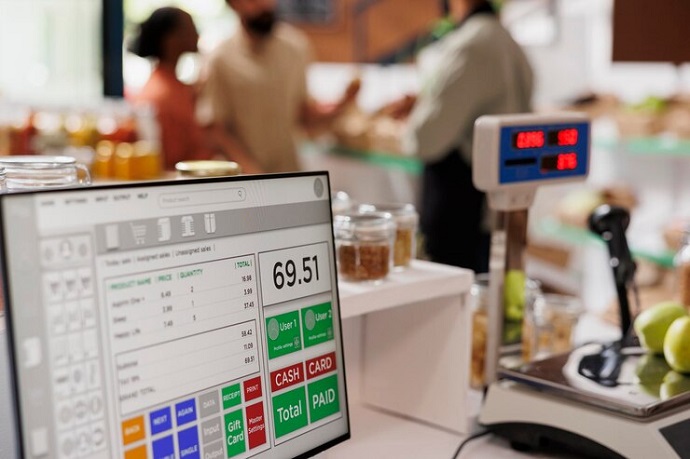How Point of Sale Systems Work
Know how the point of sales systems work, POS benefits, and ways in choosing the right point of sale system.

A Point of Sale System also know as POS system is a combination of hardware and software designed to streamline transactions, manage inventory, and facilitate customer interactions. It serves as the central hub where sales transactions are processed, inventory is tracked, and valuable business insights are generated.
Imagine strolling into your favorite cafe, placing an order for a steaming cup of coffee and a freshly baked pastry, and seamlessly completing the transaction at the checkout counter. Behind the scenes, a sophisticated system is at play – the Point of Sale (POS) system.
Components of a POS System
Hardware
The hardware components of a POS system typically include a computer or tablet, a cash register or terminal, a barcode scanner, a receipt printer, and sometimes a card reader for processing payments. These physical devices work in tandem to facilitate smooth transactions and streamline operations.
Software
The software component of a POS system encompasses the applications and programs that run on the hardware. This includes the user interface for processing sales, managing inventory, generating reports, and analyzing business data. Modern POS systems often offer cloud-based software solutions, allowing businesses to access their data remotely and integrate with other tools seamlessly.
Peripherals
In addition to the core hardware components, POS systems may incorporate peripherals such as customer-facing displays, kitchen printers for restaurants, and weighing scales for grocery stores. These peripherals enhance functionality and cater to specific industry needs.
How Point of Sale Systems Work
Now that we’ve acquainted ourselves with the basic components, let’s delve into how POS systems operate in practice. The workflow of a POS system typically unfolds as follows:
Order Entry
A cashier or staff member enters the items or services being purchased into the POS system. This can be done manually by selecting items from a menu or by scanning barcodes using a barcode scanner.
Payment Processing
Once the order is entered, the POS system calculates the total amount due, including any applicable taxes or discounts. The customer then makes payment using cash, credit/debit card, mobile wallet, or other accepted payment methods.
Transaction Completion
After payment is received, the POS system generates a receipt for the customer, detailing the items purchased, the total amount paid, and any change due. The transaction is then recorded in the system’s database for future reference.
Inventory Management
Simultaneously, the POS system updates the inventory levels based on the items sold, ensuring accurate stock tracking. This real-time inventory management feature helps businesses optimize stock levels, prevent stockouts, and identify popular items.
Benefits of Point of Sale Systems
Now that we’ve grasped the basics of POS systems, let’s explore why businesses across industries are embracing this technology with open arms:
Efficiency
POS systems streamline checkout processes, reducing wait times and improving customer satisfaction. With features like barcode scanning and automatic calculation of totals, transactions can be completed swiftly and accurately.
Inventory Control
By tracking inventory levels in real-time, POS systems enable businesses to make informed decisions about purchasing, stocking, and replenishing items. This helps minimize stockouts and overstocking, leading to optimized inventory management.
Data Insights
POS systems generate valuable data insights that can inform strategic decision-making. From sales trends and customer preferences to employee performance and profitability analysis, businesses can leverage this data to drive growth and profitability.
Enhanced Customer Experience
With features like loyalty programs, gift cards, and personalized promotions, POS systems empower businesses to enhance the overall customer experience. By rewarding loyal customers and offering tailored incentives, businesses can foster customer loyalty and drive repeat business.
Integration Capabilities
Modern POS systems often offer integration with other business tools and software, such as accounting software, CRM systems, and e-commerce platforms. This seamless integration streamlines operations, eliminates manual data entry, and fosters a more cohesive business ecosystem.
Choosing the Right Point of Sale System
Selecting the right POS system for your business is crucial for maximizing its benefits and ensuring a seamless implementation. Here are some key factors to consider when evaluating POS systems:
Business Needs
Assess your specific business needs, including the size of your business, industry requirements, and desired features. Consider factors such as inventory management, reporting capabilities, and scalability.
Hardware and Software Compatibility
Ensure that the POS system you choose is compatible with your existing hardware and software infrastructure. This includes compatibility with operating systems, peripherals, and integrations with third-party software.
User-Friendliness
Opt for a POS system that is intuitive and easy to use for both staff members and customers. A user-friendly interface can streamline training processes and minimize errors during transactions.
Security Features
Prioritize POS systems with robust security features to protect sensitive customer data and prevent unauthorized access. Look for features such as encryption, EMV compliance, and PCI DSS certification.
Customer Support and Training
Choose a POS provider that offers reliable customer support and comprehensive training resources. Prompt technical assistance and ongoing training can help ensure a smooth implementation and address any issues that may arise.
Final Thoughts
In conclusion, Point of Sale (POS) systems play a pivotal role in modernizing retail and hospitality operations, offering a myriad of benefits ranging from improved efficiency and inventory management to enhanced customer experiences and data-driven insights. By understanding the basic components, functionality, and benefits of POS systems, businesses can make informed decisions when selecting and implementing the right solution for their needs.
Whether you’re a small boutique store, a bustling restaurant, or a thriving e-commerce business, investing in a robust POS system can help you stay competitive in today’s fast-paced business landscape. With the right POS system by your side, you can streamline operations, delight customers, and drive sustainable growth for your business.
Photo Credit: